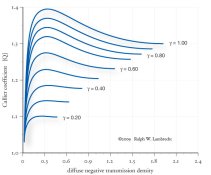Ralph,
If you are planning to publish an article about the various enlarger configurations, I would like to see a proper distinction made between the three types: condenser, diffuser, and condenser-diffusion.
I find that most published material on the issue of contrast differences tend to lump into two categories: condenser and diffuser. The adjustments in film development for G-bar/CI for condenser enlargers usually do not distinguish between point source (true condenser) enlarger and the more common condenser-diffusion enlarger, which utilizes an opal bulb and/or diffusion filter. The amount of the diffusion can vary a bit depending on the combination of bulbs/filters.
For example, Contrast Index figures for condenser enlargers are quoted in the neighborhood of 0.43 to 0.45 and diffusion enlargers are quoted as 0.56 to 0.58. In practice, my condenser-diffusion enlargers are in the neighborhood of 0.50 to 0.53. G-bar would have similar placements for the C-D enlarger.
I had to determine these variations empirically; it would have been nice to go to a published reference with confidence and save time and money.
Just a suggestion,
-F.











